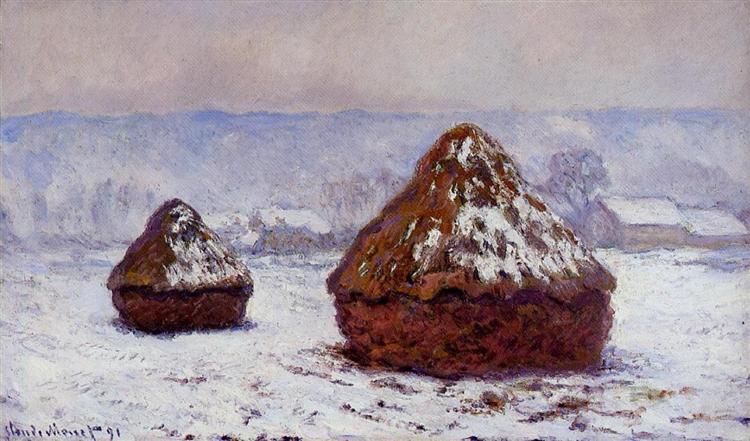Description
In his work "Grains - Snow Effect" (1891), Claude Monet captures the essence of a winter landscape through his distinctive impressionist style, where light and colour play a crucial role in the representation of nature. This painting is part of a series of works dedicated to grains or harvest heaps that Monet painted throughout his career, and once again shows his mastery in depicting seasonal changes and atmosphere.
The composition of “Grains – Snow Effect” presents a stacked and orderly accumulation of hay that appears in the center of the canvas, enveloped in an ethereal mist. The shapes are defined but slide into the realm of abstraction, where the viewer can appreciate the structure of the piles of grains while the snow covers their surface, softening the contours and creating a feeling of warmth despite the coldness suggested by the surroundings. The careful organization of these elements takes the viewer on a visual journey, driven by the soft undulations of the snow that seem to embrace the piles of hay.
Delving into the use of colour, Monet uses a symphonic palette that combines cool whites, soft blues and pale shadows, generating variations that allow the light reflected in the snow and the winter atmosphere to be captured. The technical sophistication that characterises the use of colour in this work is evident, as it plays with the interaction between the winter sunlight and the projected shadows, creating an effect of luminosity through multiple layers of brushstrokes. Nuances that evoke both the coldness of winter and a warm warmth in the reflection of light on the snow are highlighted, proposing a direct sensorial experience.
It is interesting to note that Monet's approach to depicting winter landscapes was unique for his time. Whereas other artists might have opted for a more dramatic or detailed depiction of snow, Monet chooses a lyrical approach, where the focus is on capturing the ephemeral moment, eschewing anatomical precision in favor of a more fluid and evanescent style. This move toward personal interpretation of light and atmosphere aligns closely with the principles of Impressionism, where the objective dissolves into the visual experience.
The absence of human or animal figures in the scene reinforces the idea of a landscape atomized by the winter stillness. This does not mean that the viewer does not feel a connection with the environment; on the contrary, the solitude and serenity of the vast snowy expanse provide an intimacy that invites contemplation. The presence of the grains becomes a symbol of agricultural work and rural life, while representing the passing of time and the seasons, resonating with an underlying nostalgia.
Furthermore, this work is part of a period in Monet's life when he was increasingly interested in exploring variations of light and atmosphere in his works, reflecting a never-ending quest to depict not only the physical appearance, but also the feeling of place. As in his other works, we see the influence of Japonisme in the aesthetic organization and use of space on the canvas.
In short, “Grains – Snow Effect” is a sublime statement of Monet’s ability to capture not just a scene, but the life experience it evokes. With his soft palette and masterful handling of light, Monet not only presents the snow-covered grains of hay, but invites the viewer to perceive an atmosphere rich in nuance and emotion, turning a simple winter landscape into a celebration of nature and its eternal beauty.
KUADROS ©, a famous painting on your wall.
Hand-made oil painting reproductions, with the quality of professional artists and the distinctive seal of KUADROS ©.
Painting reproduction service with satisfaction guarantee. If you are not completely satisfied with the replica of your painting, we will refund 100% of your money.

